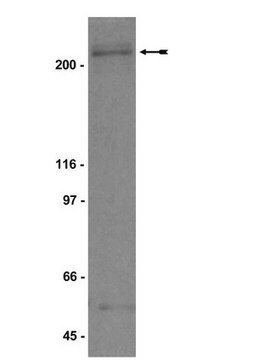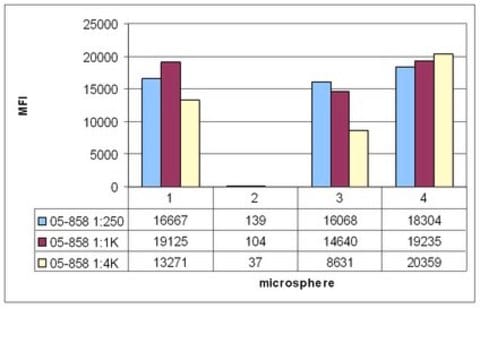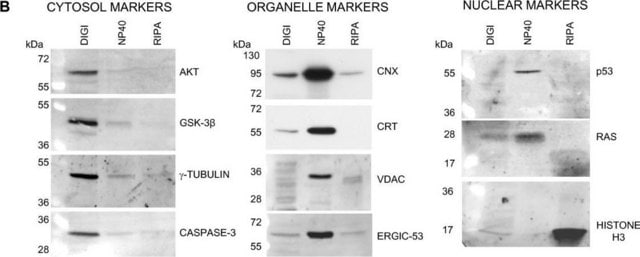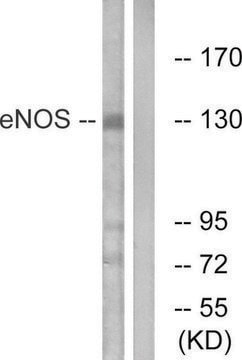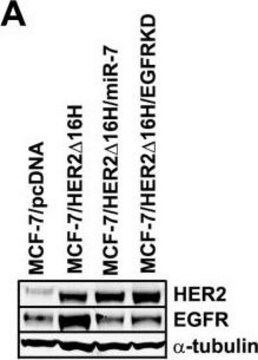추천 제품
생물학적 소스
mouse
Quality Level
항체 형태
purified antibody
항체 생산 유형
primary antibodies
클론
SD118, monoclonal
형태
liquid
포함
≤0.1% sodium azide as preservative
종 반응성
human
제조업체/상표
Calbiochem®
저장 조건
do not freeze
동형
IgG1
배송 상태
wet ice
저장 온도
2-8°C
타겟 번역 후 변형
unmodified
유전자 정보
human ... BRCA1(672)
일반 설명
Anti-BRCA1 (Ab-4), mouse monoclonal, clone SD118, recognizes the ~220 kDa BRCA1 in HBL-100 and SK-BR3 cells. It is validated for WB, IF, IP, and for frozen sections.
Purified mouse monoclonal antibody generated by immunizing RBF/DnJ mice with the specified immunogen and fusing splenocytes with NS1 mouse myeloma cells (see application references). Recognizes the ~220 kDa BRCA1 protein.
Recognizes the ~220 kDa BRCA1 protein in HBL-100 and SK-BR3 cells. Sold under license of U.S. Patent 5,753,441 and 6,162,897.
면역원
Human
a recombinant polypeptide corresponding to amino acids 1005-1313 in exon 11 of human BRCA1
애플리케이션
Frozen Sections (2 µg/ml)
Immunoblotting (2 µg/ml, see application references)
Immunofluorescence (2 µg/ml)
Immunoprecipitation (2 µg, see application references)
Paraffin Sections (not recommended)
Immunoblotting (2 µg/ml, see application references)
Immunofluorescence (2 µg/ml)
Immunoprecipitation (2 µg, see application references)
Paraffin Sections (not recommended)
포장
Please refer to vial label for lot-specific concentration.
경고
Toxicity: Standard Handling (A)
물리적 형태
In 50 mM sodium phosphate buffer, 0.2% gelatin, pH 7.5.
분석 메모
Positive Control
HBL-100 or SK-BR3 cells
HBL-100 or SK-BR3 cells
기타 정보
Chen, J.J., et al. 1999. Cancer Res.59, 1752s.
Cressman, V.L., et al. 1999. Cell Growth Differ.10, 1.
Irminger-Finger, I., et al. 1999. Biol. Chem.380, 117.
Xu, X., et al. 1999. Nat. Genet.22, 37.
Wilson, C.A., et al. 1999. Nat. Genet.21, 236.
Andres, J.L., et al. 1998. Oncogene16, 2229.
Chen, J., et al. 1998. Mol. Cell2, 317.
Chen, P.L., et al. 1998. Proc. Natl. Acad. Sci. USA95, 5287.
Fan, S., et al. 1998. Int. J. Cancer77, 600.
Gowen, L.C., et al. 1998. Science281, 1009.
Hsu, L.C. and R.L. White. 1998. Proc. Natl. Acad. Sci. USA95, 12983.
Shen, S.X., et al. 1998. Oncogene17, 3115.
Tulchin, N., et al. 1998. Int. J. Oncol.13, 513.
Ludwig, T., et al. 1997. Genes Dev11, 1226.
Ruffner, H. and I.M. Verma. 1997. Proc. Natl. Acad. Sci. USA94, 7138.
Scully, R., et al. 1997. Cell90, 425.
Thakur, S., et al. 1997. Mol. Cell Biol.17, 444.
Wilson, C.A., et al. 1997. Oncogene14, 1.
Cannon-Albright, L.A. and M.H. Skolnick. 1996. Semin Oncol.23, 1.
Chen, Y., et al. 1996. Cancer Res.56, 3168.
Liu, C.Y., et al. 1996. Genes Dev.10, 1835.
Gudas, J.M., et al. 1996. Cell Growth Differ.7, 717.
Scully, R., et al. 1996. Science272, 123.
Vaughn, J.P., et al. 1996. Cell Growth Differ.7, 711.
Wilson, C.A. et al. 1996. Nat. Genet.13, 264.
Thompson, M.E., et al. 1995. Nat. Genet.9, 444.
Miki, Y., et al. 1994. Science266, 66.
Cressman, V.L., et al. 1999. Cell Growth Differ.10, 1.
Irminger-Finger, I., et al. 1999. Biol. Chem.380, 117.
Xu, X., et al. 1999. Nat. Genet.22, 37.
Wilson, C.A., et al. 1999. Nat. Genet.21, 236.
Andres, J.L., et al. 1998. Oncogene16, 2229.
Chen, J., et al. 1998. Mol. Cell2, 317.
Chen, P.L., et al. 1998. Proc. Natl. Acad. Sci. USA95, 5287.
Fan, S., et al. 1998. Int. J. Cancer77, 600.
Gowen, L.C., et al. 1998. Science281, 1009.
Hsu, L.C. and R.L. White. 1998. Proc. Natl. Acad. Sci. USA95, 12983.
Shen, S.X., et al. 1998. Oncogene17, 3115.
Tulchin, N., et al. 1998. Int. J. Oncol.13, 513.
Ludwig, T., et al. 1997. Genes Dev11, 1226.
Ruffner, H. and I.M. Verma. 1997. Proc. Natl. Acad. Sci. USA94, 7138.
Scully, R., et al. 1997. Cell90, 425.
Thakur, S., et al. 1997. Mol. Cell Biol.17, 444.
Wilson, C.A., et al. 1997. Oncogene14, 1.
Cannon-Albright, L.A. and M.H. Skolnick. 1996. Semin Oncol.23, 1.
Chen, Y., et al. 1996. Cancer Res.56, 3168.
Liu, C.Y., et al. 1996. Genes Dev.10, 1835.
Gudas, J.M., et al. 1996. Cell Growth Differ.7, 717.
Scully, R., et al. 1996. Science272, 123.
Vaughn, J.P., et al. 1996. Cell Growth Differ.7, 711.
Wilson, C.A. et al. 1996. Nat. Genet.13, 264.
Thompson, M.E., et al. 1995. Nat. Genet.9, 444.
Miki, Y., et al. 1994. Science266, 66.
Maximal BRCA1 levels are observed in subconfluent cell populations after serum stimulation. Highly specific BRCA1 antibody useful for blotting and IP of full length BRCA1 protein. Antibody should be titrated for optimal results in individual systems.
법적 정보
Sold under license of U.S. Patents 5,753,441 and 6,162,897.
CALBIOCHEM is a registered trademark of Merck KGaA, Darmstadt, Germany
Not finding the right product?
Try our 제품 선택기 도구.
Storage Class Code
11 - Combustible Solids
WGK
WGK 1
Flash Point (°F)
Not applicable
Flash Point (°C)
Not applicable
시험 성적서(COA)
제품의 로트/배치 번호를 입력하여 시험 성적서(COA)을 검색하십시오. 로트 및 배치 번호는 제품 라벨에 있는 ‘로트’ 또는 ‘배치’라는 용어 뒤에서 찾을 수 있습니다.
Veronica Gomez Godinez et al.
PloS one, 15(4), e0227849-e0227849 (2020-04-29)
Understanding the mitotic DNA damage response (DDR) is critical to our comprehension of cancer, premature aging and developmental disorders which are marked by DNA repair deficiencies. In this study we use a micro-focused laser to induce DNA damage in selected
Maria C Villarroel et al.
Molecular cancer therapeutics, 10(1), 3-8 (2010-12-08)
Metastasis and drug resistance are the major causes of mortality in patients with pancreatic cancer. Once developed, the progression of pancreatic cancer metastasis is virtually unstoppable with current therapies. Here, we report the remarkable clinical outcome of a patient with
Myth T S Mok et al.
Traffic (Copenhagen, Denmark), 13(6), 800-814 (2012-03-17)
The breast cancer associated gene 1 (BRCA1)-A protein complex assembles at DNA damage-induced nuclear foci to facilitate repair of double-stranded breaks. Here, we describe the first systematic comparison of the dynamics, copy number and organization of its core components at
Amandine I Garcia et al.
EMBO molecular medicine, 3(5), 279-290 (2011-04-08)
Germ-line mutations in the BRCA1 gene strongly predispose women to breast cancer (lifetime risk up to 80%). Furthermore, the BRCA1 protein is absent or present at very low levels in about one third of sporadic breast cancers. However, the mechanisms
M Tanikawa et al.
British journal of cancer, 104(8), 1349-1355 (2011-03-17)
The TFII-I is a multifunctional transcriptional factor known to bind specifically to several DNA sequence elements and to mediate growth factor signalling. A microdeletion at the chromosomal location 7q11.23 encoding TFII-I and the related family of transcription factors may result
자사의 과학자팀은 생명 과학, 재료 과학, 화학 합성, 크로마토그래피, 분석 및 기타 많은 영역을 포함한 모든 과학 분야에 경험이 있습니다..
고객지원팀으로 연락바랍니다.